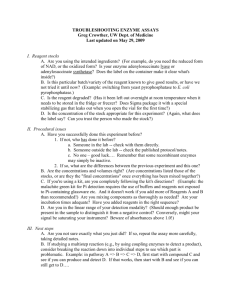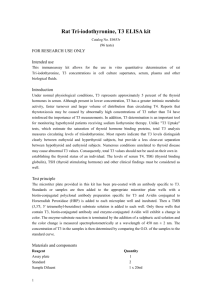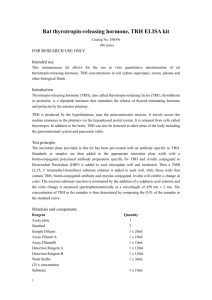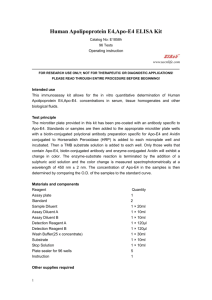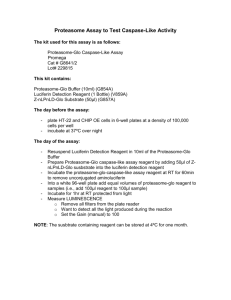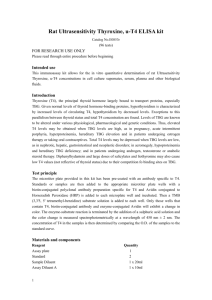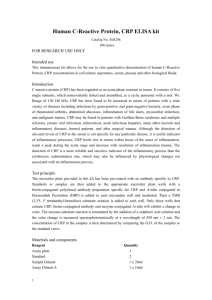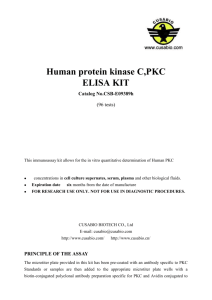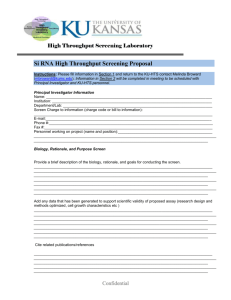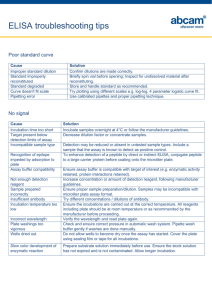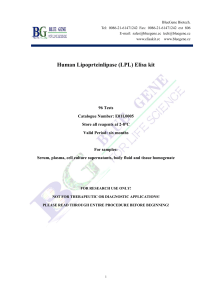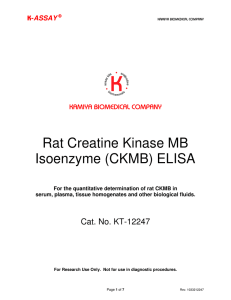Human dopamine,DA ELISA KIT
advertisement
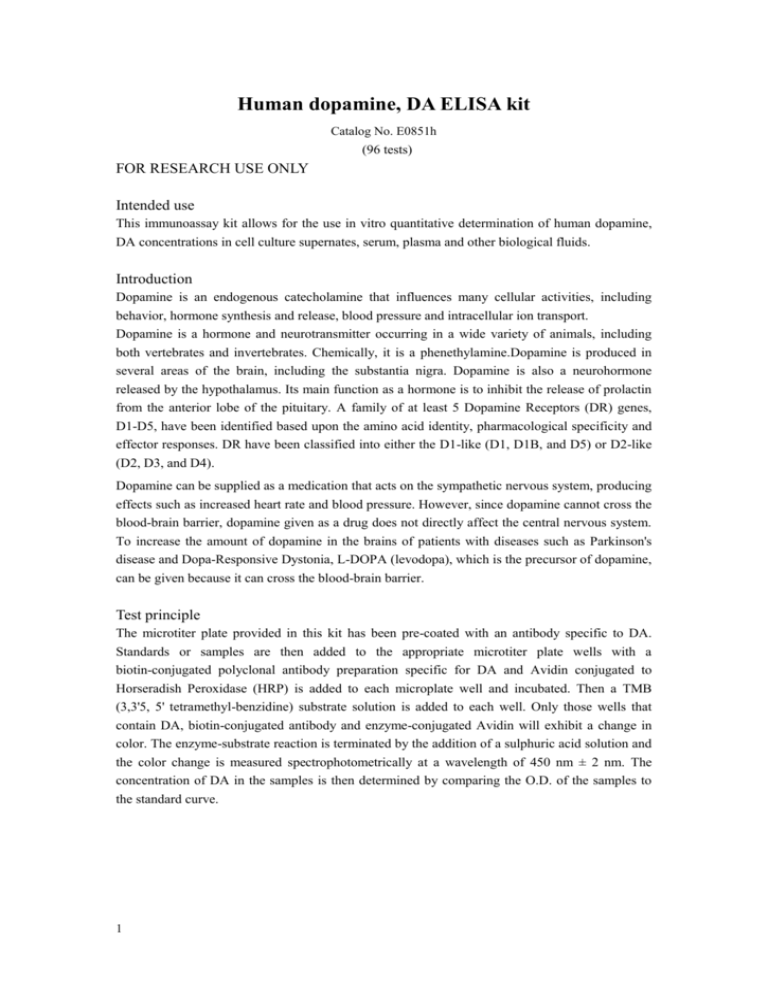
Human dopamine, DA ELISA kit Catalog No. E0851h (96 tests) FOR RESEARCH USE ONLY Intended use This immunoassay kit allows for the use in vitro quantitative determination of human dopamine, DA concentrations in cell culture supernates, serum, plasma and other biological fluids. Introduction Dopamine is an endogenous catecholamine that influences many cellular activities, including behavior, hormone synthesis and release, blood pressure and intracellular ion transport. Dopamine is a hormone and neurotransmitter occurring in a wide variety of animals, including both vertebrates and invertebrates. Chemically, it is a phenethylamine.Dopamine is produced in several areas of the brain, including the substantia nigra. Dopamine is also a neurohormone released by the hypothalamus. Its main function as a hormone is to inhibit the release of prolactin from the anterior lobe of the pituitary. A family of at least 5 Dopamine Receptors (DR) genes, D1-D5, have been identified based upon the amino acid identity, pharmacological specificity and effector responses. DR have been classified into either the D1-like (D1, D1B, and D5) or D2-like (D2, D3, and D4). Dopamine can be supplied as a medication that acts on the sympathetic nervous system, producing effects such as increased heart rate and blood pressure. However, since dopamine cannot cross the blood-brain barrier, dopamine given as a drug does not directly affect the central nervous system. To increase the amount of dopamine in the brains of patients with diseases such as Parkinson's disease and Dopa-Responsive Dystonia, L-DOPA (levodopa), which is the precursor of dopamine, can be given because it can cross the blood-brain barrier. Test principle The microtiter plate provided in this kit has been pre-coated with an antibody specific to DA. Standards or samples are then added to the appropriate microtiter plate wells with a biotin-conjugated polyclonal antibody preparation specific for DA and Avidin conjugated to Horseradish Peroxidase (HRP) is added to each microplate well and incubated. Then a TMB (3,3'5, 5' tetramethyl-benzidine) substrate solution is added to each well. Only those wells that contain DA, biotin-conjugated antibody and enzyme-conjugated Avidin will exhibit a change in color. The enzyme-substrate reaction is terminated by the addition of a sulphuric acid solution and the color change is measured spectrophotometrically at a wavelength of 450 nm ± 2 nm. The concentration of DA in the samples is then determined by comparing the O.D. of the samples to the standard curve. 1 Materials and components Reagent Assay plate Standard Sample Diluent Assay Diluent A Assay DiluentB Detection Reagent A Detection Reagent B Wash Buffer (25 x concentrate) Substrate Stop Solution Plate sealer for 96 wells Quantity 1 2 1 x 20ml 1 x 10ml 1 x 10ml 1 x 120ul 1 x 120ul 1 x 30ml 1 x 10ml 1 x 10ml 1x5 Sample collection and storage Serum - Use a serum separator tube (SST) and allow samples to clot for 30 minutes before centrifugation for 15 minutes at approximately 1000 x g. Remove serum and assay immediately or aliquot and store samples at -20° C or -80° C. Plasma - Collect plasma using EDTA or heparin as an anticoagulant. Centrifuge samples for 15 minutes at 1000 x g at 2 - 8° C within 30 minutes of collection. Store samples at -20° C or -80° C. Avoid repeated freeze-thaw cycles. Cell culture supernates and other biological fluids - Remove particulates by centrifugation and assay immediately or aliquot and store samples at -20° C or -80° C. Avoid repeated freeze-thaw cycles. Note: Serum, plasma, and cell culture supernatant samples to be used within 7 days may be stored at 2-8 ° C, otherwise samples must stored at -20° C (≤ 3 months) or -80° C (≤ 6 months) to avoid loss of bioactivity and contamination. Avoid freeze-thaw cycles. When performing the assay slowly bring samples to room temperature. It is recommended that all samples be assayed in duplicate. DO NOT USE HEAT-TREATED SPECIMENS. Limitations of the procedure FOR RESEARCH USE ONLY. NOT FOR USE IN DIAGNOSTIC PROCEDURES. 1. The kit should not be used beyond the expiration date on the kit label. 2. Do not mix or substitute reagents with those from other lots or sources. 3. If samples generate values higher than the highest standard, further dilute the samples with the Assay Diluent and repeat the assay. Any variation in standard diluent, operator, pipetting technique, washing technique,incubation time or temperature, and kit age can cause variation in binding. 4. This assay is designed to eliminate interference by soluble receptors, ligands, binding proteins, and other factors present in biological samples. Until all factors have been tested in the Quantikine Immunoassay, the possibility of interference cannot be excluded. 2 Reagent preparation Bring all reagents to room temperature before use. Wash Buffer - If crystals have formed in the concentrate, warm to room temperature and mix gently until the crystals have completely dissolved. Dilute 30 mL of Wash Buffer Concentrate into deionized or distilled water to prepare 750 mL of Wash Buffer. Standard - Reconstitute the Standard with 1.0 mL of Sample Diluent. This reconstitution produces a stock solution of 10,000 pg/mL. Allow the standard to sit for a minimum of 15 minutes with gentle agitation prior to making serial dilutions. Please firstly dilute the stock solution to 1,000 pg/mL and the diluted standard serves as the high standard (1,000 pg/mL). The Sample Diluent serves as the zero standard (0 pg/mL). pg/mL 10,000 1,000 500 250 125 62.5 31.2 15.6 0 Detection Reagent A and B - Dilute to the working concentration specified on the vial label using Assay Diluent A and B (1:100), respectively. Assay procedure Allow all reagents to reach room temperature. All the reagents should be mixed thoroughly by gently swirling before pipetting. Avoid foaming. Arrange and label required number of strips. Prepare all reagents, working standards and samples as directed in the previous sections. 1. Add 100 uL of Standard, Blank, or Sample per well. Cover with the Plate sealer. Incubate for 2 hours at 37° C. 2. Remove the liquid of each well, don’t wash. 3. Add 100 uL of Detection Reagent A working solution to each well. Cover with the Plate sealer. Incubate for 1 hour at 37°C. Detection Reagent A working solution may appear cloudy. Warm to room temperature and mix gently until solution appears uniform. 4. Aspirate each well and wash, repeating the process three times for a total of three washes. Wash by filling each well with Wash Buffer (350 uL) using a squirt bottle, multi-channel pipette, manifold dispenser or autowasher. Complete removal of liquid at each step is essential to good performance. After the last wash, remove any remaining Wash Buffer by aspirating or decanting. Invert the plate and blot it against clean paper towels. 5. Add 100 uL of Detection Reagent B working solution to each well. Cover with a new Plate sealer. Incubate for 1 hours at 37° C. 6. Repeat the aspiration/wash as in step 4. 7. Add 90 uL of Substrate Solution to each well. Cover with a new Plate sealer. Incubate within 30 minutes at 37°C. Protect from light. 8. Add 50 uL of Stop Solution to each well. If color change does not appear uniform, gently tap 3 9. the plate to ensure thorough mixing. Determine the optical density of each well at once, using a microplate reader set to 450 nm. Specificity This assay recognizes recombinant and natural human DA. No significant cross-reactivity or interference was observed. Sensitivity The minimum detectable dose of human DA is typically less than 7.8 pg/mL. The sensitivity of this assay, or Lower Limit of Detection (LLD) was defined as the lowest detectable concentration that could be differentiated from zero. Detection Range 15.6-1,000 pg/mL. The standard curve concentrations used for the ELISA’s were 1,000 pg/mL, 500 pg/mL, 250 pg/mL, 125 pg/mL, 62.5 pg/mL, 31.2 pg/mL, 15.6 pg/mL. Important Note: 1. Please carefully reconstitute Standards or working Detection Reagent A and B according to the instruction, and avoid foaming and mix gently until the crystals have completely dissolved. The reconstituted Standards can be used only once. 2. The wash procedure is critical. Insufficient washing will result in poor precision and falsely elevated absorbance readings. 3. It is recommended that no more than 32 wells be used for each assay run if manual pipetting is used since pipetting of all standards, specimens and controls should be completed within 5 minutes. A full plate of 96 wells may be used if automated pipetting is available. 4. Duplication of all standards and specimens, although not required, is recommended. 5. When mixing or reconstituting protein solutions, always avoid foaming. 6. To avoid cross-contamination, change pipette tips between additions of each standard level, between sample additions, and between reagent additions. Also, use separate reservoirs for each reagent. 7. To ensure accurate results, proper adhesion of plate sealers during incubation steps is necessary. 8. Do not substitute reagents from one kit lot to another. Use only the reagents supplied by manufacturer. Calculation of results Average the duplicate readings for each standard, control, and sample and subtract the average zero standard optical density. Create a standard curve by reducing the data using computer software capable of generating a four parameter logistic (4-PL) curve-fit. As an alternative, construct a standard curve by plotting the mean absorbance for each standard on the y-axis against the concentration on the x-axis and draw a best fit curve through the points on the graph. The data may be linearized by plotting the log of the DA concentrations versus the log of the O.D. and the best fit line can be determined by regression analysis. This procedure will produce an adequate but less precise fit of the data. If samples have been diluted, the concentration read from the standard 4 curve must be multiplied by the dilution factor. Storage of test kits and instrumentation 1. Unopened test kits should be stored referring to the package label for frequent use, and stored at -20°C for long time storage. The microtiter plate should be kept in a sealed bag with desiccants to minimize exposure to damp air. The test kit may be used throughout the expiration date of the kit (six months from the date of manufacture). Opened test kits will remain stable until the expiring date shown, provided it is stored as prescribed above. 2. Opened test kits will remain stable until the expiring date shown, provided it is stored as prescribed above. 3. Do not remove microtiter plate from the storage bag until needed. Unused strips should be stored at 2-8°C in their pouch with the desiccant provided. 4. A microtiter plate reader with a bandwidth of 10nm or less and an optical density range of 0-3 OD or greater at 450nm wavelength is acceptable for use in absorbance measurement. 5. Use fresh disposable pipette tips for each transfer to avoid contamination. 6. Substrate Solution is easily contaminated. If bluish prior to use, do not use. Precaution The Stop Solution suggested for use with this kit is an acid solution. Wear eye, hand, face, and clothing protection when using this material. 5
